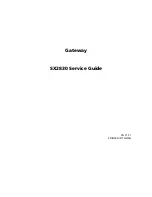
Your requirement can be categorized as one or the other of these two options:
• Accessing RTU devices from TCP
• Accessing TCP devices from RTU
To access RTU devices from TCP, you need only set the IP address of the gateway, and
set the RTU port parameters such as baud rate. Refer to section 4 in this user guide
for instructions if you will be accessing RTU devices from TCP.
To access TCP devices from RTU, in addition to setting the IP address of the gateway
itself and setting the RTU port parameters, you will need to create a table that maps
IP addresses of the TCP devices to an RTU addresses. This becomes a lookup table
that the gateway uses to forward RTU requests to the correct TCP device. Refer to
section 5 in this user guide for instructions if you will be accessing TCP devices from
RTU.
2.2.2 How RTU Translates to TCP or Vice Versa
The Babel Buster BB3-6101-GW and MX-61-GW are non-mapping Modbus gateways
used to simply forward Modbus RTU requests and responses to Modbus TCP, and vice
versa. Most Control Solutions gateways involve mapping, and the gateway itself
contains registers or objects which hold copies of data found in other devices. This
intermediate data buffering is what allows access to the same data from multiple
protocols. The non-mapping gateway discussed here does not contain any of its own
registers. It simply forwards whatever request it receives to the other side by simply
repackaging and retransmitting exactly the same request (regardless of whether it was
a correct request).
The process of "repackaging" the Modbus request or response is illustrated below. The
core of a Modbus data packet is the same for RTU and TCP. It contains a slave
address (or unit number), a function code, and some data. The "data" is most often a
starting register number, register count, and register data (if writing).
2. Connecting Gateway for the First Time
file:///C:/AAA_CSI/Literature/2021 User Guides/BB3-6101-MX-61 Use...
2 of 6
5/4/2021, 9:55 AM







































